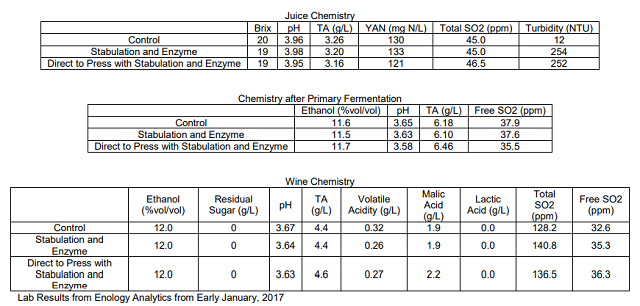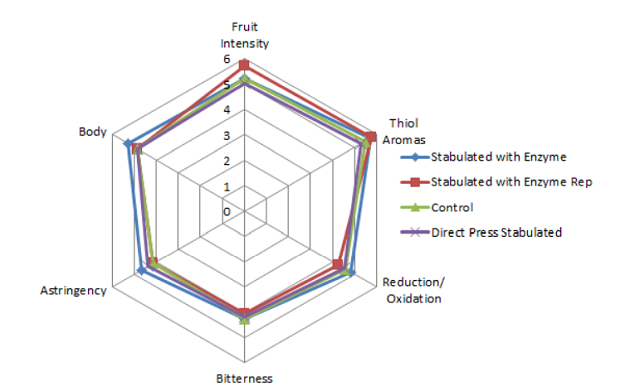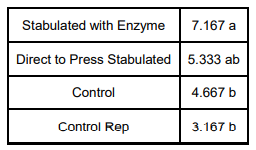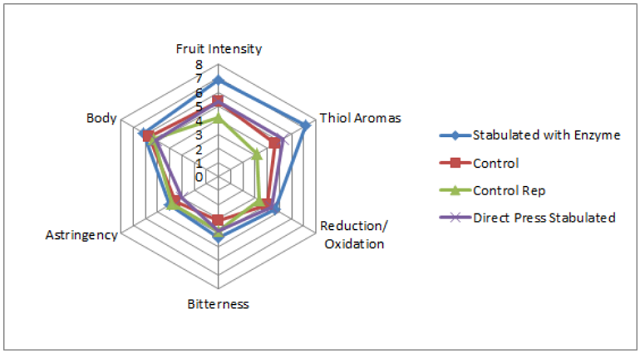The Effect of Stabulation on Fermentation Kinetics and Sensory Quality (ARC) (2016)
Matthieu Finot
King Family Vineyards
Summary
This study examines the effect of different rosé must processing techniques on the chemical and sensory qualities of finished wine. Merlot grapes were either sent directly to press or cold soaked for two days prior to pressing. After cold soak and pressing, juice was either settled and inoculated or stabulated for approximately 5 days, after which it was inoculated and a Laffort thiolase enzyme was added. Merlot sent directly to press underwent stabulation. Not many chemical differences could be seen between stabulated juices with the control, except a higher initial turbidity. These results suggest that for this particular style of rose winemaking, judges preferred wine made from the two-day cold soak, regardless of stabulation. Although the stabulated and control wines were found to be significantly different, no major trends could be seen for the descriptors used in this study except for perhaps a slight increase in fruit intensity and thiol aromas. No major preference could be seen for the control wine and stabulated wine, suggesting that stabulation can act as a technique to process wine without much altering the flavor profile in a negative matter.
Introduction
For white and rosè juices, juice processing techniques can greatly enhance or degrade the aromatic and physical characteristics of the resulting wine. As such, often winemakers desire to settle and ferment white juice as soon as possible, in order to reduce the risk for oxidation in stored juice, and to minimize the impact of gross lees on development of later reductive qualities. Inoculation effectively protects the juice from further oxidation, and helps liberate many thiol-derived aroma characteristics that were present grape particulate matter. However, racking off gross lees effectively limits further liberation of grape-derived aroma compounds, which can limit the aromatic potentiality of wine. Finding a balance between oxidizing these aroma precursors due to poor storage conditions while maximizing aromatic extraction from grape particulates is a challenge in white and rosè winemaking. Stabulation is a technique which may allow for more extraction of these compounds from gross lees while minimizing juice oxidation. Stabulation is when partially clarified juice is held at low temperatures for a set amount of time prior to fermentation. The settled lees are often stirred anoxically (often by adding dry ice to the tank to rouse the lees) in order to extract more aroma precursors. The juice is held at a low temperature to minimize oxidation, and is frequently gassed or roused with dry ice to further sparge the tank. The following table lists generic stabulation times at set juice temperatures (Salamone 2016).

After stabulation is complete, the juice is allowed to increase to 10°C, racked off the stabulation lees, and is inoculated. Laffort has developed an enzyme which may help to further release the thiol aromatic precursors, and this enzyme is added concurrently with inoculation (Salamone 2016). This thiol enzyme is thought to be a pectinase with some proteinase side activity, which may act as a thiolase which helps to deconjugate thiol precursors from Saccharomyces cell membranes (Salamone personal communication, 2016). This study examines the impact of stabulation on rosè winemaking at low temperatures with the Laffort enzyme.
Results and Discussion
Not many chemical differences could be seen between stabulated juices with the control, except a higher initial turbidity.

The wine was tasted at two different sensory sessions. On the January 25 session at Early Mountain Vineyards, of 38 people who answered, 22 people chose the correct wine (58%), showing a statistically significant difference between wines (p<0.05). These wines were voted to have an average degree difference of 4.6 (out of 10), suggesting that the wines were moderately different. In general, people who answered correctly preferred the stabulated treatment to the control (although this was a weak preference), and preferred the direct to press treatment the least.

In general, no major trends could be seen with the descriptors used in this study on the January 25 tasting. There was a slight tendency for the Stabulation with Enzyme treatment to increase Body, Astringency, and Fruit Intensity, but this was weak.

For the February 15 tasting at Williamsburg Winery, out of 10 judges only 5 correctly distinguished the different wine (50%). Thus, no significant differences between the wine that was stabulated with enzyme versus the control wine could be distinguished through a triangle test. In general, people tended to prefer the stabulated wines, especially the wine that was cold soaked for two days. The control was often the least preferred. However, these preferences are only out of 5 judges, so should not be interpreted too strictly.

There was a strong trend for the Stabulated treatment with Enzyme to have higher thiol aromatics than the control (LSD = 2.50). The Stabulated with Enzyme treatment had a slight tendency to have higher Fruit Intensity and Bitterness.


These results suggest that for this particular style of rose winemaking, judges preferred wine made from the two-day cold soak. Although the stabulated and control wines were found to be significantly different at the January 25 tasting, no major trends could be seen for the descriptors used in this study except for perhaps a slight increase in fruit intensity and thiol aromas. No major preference could be seen for the control wine and stabulated wine, suggesting that stabulation can act as a technique to process wine without having much negative impact. This could be useful as a means to consolidate tank space. If grapes are being harvested over several days, the juice from these grapes can be stored in the same vessel in order to decrease labor, equipment, and space costs required to process the juice. This could effectively act as an extended period of cold settling for juice. More research needs to be done to confirm whether adding juice to the same tank over multiple days has a small impact on quality.
Methods
This project used Merlot grapes sourced from Ivy Creek Vineyard. The direct-to-press treatment was from a pick on 9/13/2016 and the two skin contact treatments was from a pick on 9/14/2016. The two skin-contact treatments were the main study, and the direct to press treatment was a stylistic variant on the stabulation.
The direct-to-press treatment (harvested 9/13) were from a 3.98 ton harvest of Merlot, and was pressed that day at a yield of 675 L/ton (for a total of 2688 L). Lafazyme Press was added to the grapes at a rate of 4.018g/hL. Sulfur dioxide was added at a rate of 4.65g/hL. This wine was allowed to settle and sit on its lees for 5 days, upon which it was racked off the lees on 9/18. The next day the juice was acidulated with 200g/hL tartaric acid and 50g/hL malic acid. A Laffort thiol enzyme was then added at 5g/hL, and the juice was inoculated with 15.686g/hL Actiflore Rose Yeast. At this point juice analysis was performed. On 9/23 bentonite and casein were added at rates of 40g/hL and 20g/hL, respectively, and the day after the fermenting juice was treated with 20g/hL Fermaid K and 30g/hL Fresharom. Post-AF analysis was performed in-house on 10/12, and the wine was stabilized on 10/20 with 5g/hL sulfur dioxide.
The two skin contact treatments (harvested 9/14) were from a 4.05 ton harvest of Merlot, and was held in a refrigerated truck for 2 days (until 9/16). Prior to storing in the truck, 4.938 g/hL Lafazym Extract and 2g/hL sulfur dioxide were added to the grapes. The Merlot was pressed on 9/16 into tank with an addition of 2.5g/hL sulfur dioxide. After settling for a day, the juice was then split so that the stabulation treatment was placed in one tank, and the control was racked into a separate stainless steel tank to settle overnight before being racked the next day into a square tank.
At this point the control juice analyzed was inoculated with Actiflore Rose at 18.2g/hL. The next day 200g/hL tartaric acid and 50g/hL malic acid were added. On 9/22 20g/hL Fermaid K were added, and on 9/23 40g/hL bentonite, 20g/hL casein, and 30g/hL Fresharom were added. On 9/24 30g/hL Fermaid O were added. On 10/20 the wine was stabilized with 5g/hL sulfur dioxide.
The treatment for stabulation was held in the post-press tank from 9/16 until 9/21 for stabulation, at which point it was transferred to a square tank and sent for in-house juice analysis. On 9/21 the juice was acidulated and inoculated at the same rates as the control, except that it also had the Laffort Thiol enzyme was added at 5g/hL. This fermenting juice received the same additions at the same rates, and after the same amount of time had passed as the control. The wine was stabilized on 10/20 with 5g/hL sulfur dioxide. 35 ppm free sulfur dioxide was maintained on all three wines.
For the triangle test and preference analysis for the January 25 tasting, anybody who did not answer the form were removed from consideration for both triangle, degree of difference, and preference. Additionally, anybody who answered the triangle test incorrectly were removed from consideration for degree of difference and preference. Additionally, any data points for preference which did not make sense (such as a person ranking a wine and its replicate at most and least preferred, when they correctly guessed the odd wine) were removed.
In order to balance the data set to perform statistical analysis for descriptive analysis on the January 25 tasting, any judge who had not fully completed the descriptive analysis ratings were removed. In order to then make the number of judges between groups equivalent, one judge from group 1 was transferred to group 3, and another judge from group 1 was eliminated. This resulted in a final data set of 3 groups, each with 9 judges (considered as replications within groups, and groups were considered as assessors). Data was analyzed using Panel Check V1.4.2. Because this is not a truly statistical set-up, any results which are found to be statistically significant (p<0.05) will be denoted as a “strong trend” or a “strong tendency,” as opposed to general trends or tendencies. The statistical significance here will ignore any other significant effects or interactions which may confound the results (such as a statistically significant interaction of Judge x Wine confounding a significant result from Wine alone). The descriptors used in this study were Fruit Intensity, Thiol Aromas, Reduction/Oxidation (on a scale from most reduced to most oxidized), Bitterness, Astringency, and Body.
The same procedures for data analysis were used on the February 15 tasting. In this tasting, each group only had two judges, for a total of 6 judges. Thus, these results are not very strong statistically.
References
Salamone, P. 2016. Laffort Stabulation Protocol (ARC).
Salamone, P. 2016. Personal Communication.
